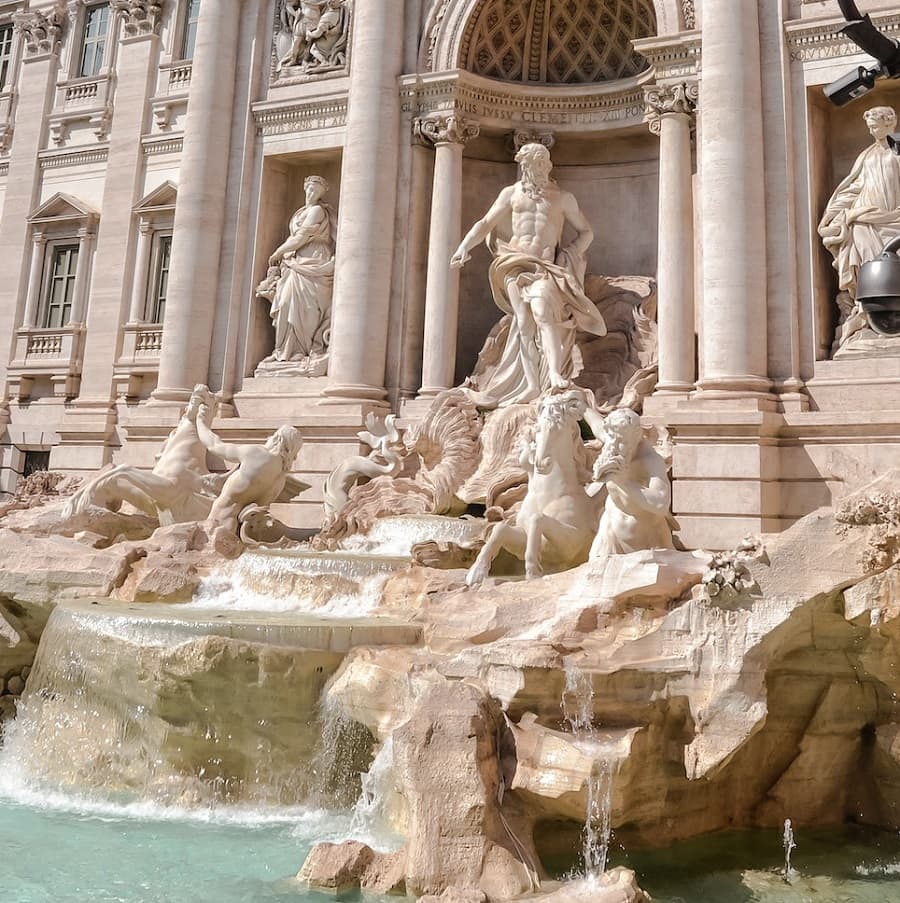Trevi Fountain in Rome: Iconic & Ancient Landmark
Last Updated on 4th December 2023 by admin
Rome, often referred to as the Eternal City, is a treasure trove of historical and architectural wonders. Among its many iconic landmarks, the Fontana di Trevi, or Trevi Fountain is the most famous fountain in Rome, stands as a symbol of timeless beauty and cultural significance. In this comprehensive exploration, we will delve into the rich history, captivating legends, and architectural brilliance of The Trevi Fountain (Fontana di Trevi).
Trevi Fountain Brief History
The Trevi Fountain, an iconic masterpiece of Baroque architecture, was constructed during the 18th century. Its creation began in 1732 under the skilled guidance of Italian architect Nicola Salvi and was completed in 1762 by Giuseppe Pannini, following Salvi’s design.
The name “Trevi” is derived from the Latin words “Treium Vorum,” which refer to the three roads that converged at the location of the fountain. Over time, “Treium Vorum” evolved into “Trevi,” and this name has been associated with the iconic fountain ever since.
But what prompted the construction of this grand monument? At its core, the Trevi Fountain was born out of a practical need – the need for a reliable source of clean, potable water in Rome. In the 18th century, Rome’s growing population faced a constant challenge: access to fresh water. While the city was graced with magnificent aqueducts, they couldn’t fully satisfy the thirst of the Roman populace. This is where the Trevi Fountain came into play.
The fountain was strategically placed at the terminal point of one of the ancient aqueducts, the Aqua Virgo, to provide a source of clean water to the local residents. Its ornate design and sculptures not only served an aesthetic purpose but also celebrated the importance of water, paying homage to Oceanus, the god of water in Roman mythology.
The Legend of Trevi
In the heart of Rome lies a legend, etched into the very stone of the city. The Trevi Fountain, with its awe-inspiring architecture and rich history, beckons travelers from every corner of the globe to uncover its secrets. It is listed at the top of the famous fountain in Rome, even in the world.
A Wishful Beginning:
The Trevi Fountain’s origin story harks back to the first century B.C. In ancient Rome, clean, potable water was a precious commodity, and the city’s aqueducts couldn’t entirely quench the thirst of its populace. Enter a young Roman girl named Trivia, who stumbled upon a hidden spring gushing with pristine water. Her altruistic act of revealing this treasure to parched Roman soldiers earned their profound gratitude.
To immortalize this benevolence, the soldiers decided to construct a grand fountain at the very spot where the spring was found. This marked the birth of the Trevi Fountain, a symbol of hope and kindness. Commissioned to provide water and embody the spirit of generosity, it has since become an iconic masterpiece in the heart of Rome, attracting millions of visitors who, in a tradition born of gratitude, toss coins into its waters with the hope of returning to this eternal city. Thus, the Trevi Fountain’s wishful beginning has left an indelible mark on history, reminding us of the power of simple acts of goodness.
A Love Story:
Beyond its historical significance, the Trevi Fountain is steeped in the enchantment of love and romance. Its fame as a symbol of love owes much to the 1954 cinematic masterpiece, “Three Coins in the Fountain.” This film artfully weaves a tale of three young women, each working and living in Rome, who are united by their shared desire for love and romance.
The heart of the story revolves around the Trevi Fountain itself, where these three women make their wishes by tossing coins into its crystalline waters. Each coin represents a unique wish related to love, be it finding a soulmate, rekindling a lost love, or simply experiencing the magic of love in the Eternal City.
As the coins glisten in the fountain’s depths, they carry with them the dreams and desires of the characters, reflecting the timeless belief in the power of the Trevi Fountain to grant wishes of the heart. This cinematic portrayal has forever linked the Trevi Fountain to the themes of love and destiny, captivating the imagination of romantics worldwide.
Today, visitors from across the globe continue to be inspired by this love story, as they too participate in the tradition of tossing coins into the Trevi Fountain, all the while hoping for their own love wishes to come true amidst the timeless beauty of Rome.
The Fountain’s Architecture
The Trevi Fountain is not just a work of art; it’s an architectural marvel that has left an indelible mark on the world of architecture design. The Trevi Fountain’s architectural splendor is a testament to the grandeur and artistic vision of its time, beckoning travelers from across the world to admire its beauty.
Baroque Beauty:
The Trevi Fountain is an exquisite representation of Baroque architecture, designed by the 18th-century Italian architect, Nicola Salvi. Its intricate and ornate design is a testament to the Baroque style’s penchant for elaborate details and dramatic aesthetics.
The fountain’s centerpiece features Oceanus, the Roman god of water, riding a magnificent chariot pulled by two powerful seahorses. This colossal sculpture exudes grandeur and artistry, showcasing the skill of the craftsmen who brought Salvi’s vision to life.
Every facet of the Trevi Fountain is adorned with intricate carvings, reliefs, and statues, illustrating the meticulous attention to detail that defines Baroque architecture. Water flows gracefully from the hands of Oceanus into the basin below, creating a captivating visual and auditory experience.
Visitors to the Trevi Fountain are enveloped in a sensory journey, where they can appreciate the visual splendor, the soothing sound of flowing water, and the profound artistic achievement of the Baroque era. This architectural masterpiece stands as a remarkable testament to the grandeur of Rome and the enduring allure of Baroque beauty.
Mythological Marvel:
At the heart of the Trevi Fountain lies a captivating mythological marvel that adds depth and symbolism to its already impressive architecture. This central figure is none other than Oceanus, the ancient Roman god of water, and his presence is nothing short of awe-inspiring.
Oceanus is depicted in a majestic chariot, drawn by two magnificent seahorses. This monumental sculpture, intricately carved and sculpted, symbolizes the profound importance of water in Rome’s history and culture. It pays homage to the aqueducts that once supplied the city with its life-giving water, ensuring its survival and prosperity.
The grandeur of Oceanus and his chariot atop the fountain is a testament to the skill and artistry of the craftsmen who painstakingly created this masterpiece. As visitors gaze upon this mythological marvel, they are transported to a time when gods and legends were an integral part of daily life in Rome.
The cascading water from Oceanus’s hands into the fountain’s basin below adds an element of grace and serenity to the scene, creating a harmonious blend of sculpture and water that characterizes Baroque fountains.
Trevi Fountain’s Statue Showcase
The Trevi Fountain is adorned with a stunning array of famous statues and sculptures, each intricately crafted and full of symbolism. Here is a brief description of some of the key statues:
- Oceanus: The central figure and focal point of the fountain is Oceanus, the Roman god of water. He is depicted riding a chariot pulled by two powerful seahorses. Oceanus stands tall and majestic, representing the importance of water to the city of Rome.
- Abundance and Salubrity: Flanking Oceanus are two statues, Abundance and Salubrity. Abundance is often portrayed holding a sheaf of wheat, symbolizing prosperity, while Salubrity holds a cup from which a snake drinks, representing health and well-being.
- Travertine Rock: The rocks and formations behind the statues give the impression of a natural grotto. The water flows from various spouts and crevices, creating a harmonious blend of art and nature.
- The Tritons: On either side of Oceanus, there are two Triton figures, half-man and half-fish. They are seen taming seahorses, emphasizing the power and control over the seas.
- Niche Statues: Above the central arch, there are four statues in niches, each representing different concepts. These statues represent Agrippa, who ordered the construction of the Aqua Virgo aqueduct; the Virgin Aqueduct, symbolizing purity; Healthiness, representing the purity of the water; and Virility, symbolizing the strength of the water.
- Reliefs and Ornamental Details: Throughout the facade of the fountain, you’ll find intricate reliefs, decorative elements, and ornate carvings that depict various scenes and motifs, adding to the fountain’s overall grandeur.
These statues and sculptures collectively tell a visual story that celebrates the importance of water, health, abundance, and the enduring legacy of Rome. They contribute to the Trevi Fountain’s status as one of the world’s most magnificent and symbolic artistic achievements.
A Coin for a Wish
The Trevi Fountain, besides its architectural grandeur and mythological marvel, is famous for a timeless tradition that draws visitors from around the world – the act of tossing a coin into its crystalline waters.
The Tradition:
One of the most enduring traditions associated with the Trevi Fountain is the simple yet powerful act of tossing a coin over your left shoulder with your right hand. Visitors of all ages, nationalities, and backgrounds participate in this age-old ritual, often with a wish in their hearts and a sense of wonder in their eyes.
The Magic Number:
But there’s more to this tradition than meets the eye. It’s not just one coin that is tossed; it’s three. Each coin represents a unique wish: one for a return to Rome, one for finding love in the Eternal City, and one for ensuring a future marriage. It’s a belief that has transcended generations, a whispered secret shared among those who have stood before the Trevi Fountain.
This tradition adds a layer of enchantment to the fountain’s allure, making it a place where dreams are cast into the crystal-clear waters in the hope that they will come true. As the coins glimmer beneath the surface, they carry with them the collective desires of countless individuals who have been captivated by the Trevi Fountain’s magic. It’s a reminder that in this enchanting corner of Rome, wishes are not just made; they have a chance to be fulfilled, ensuring that the Trevi Fountain remains a symbol of hope, dreams, and the enduring romance of the Eternal City.
Trevi Fountain in Popular Culture
The Trevi Fountain’s fame extends far beyond its architectural magnificence and historical significance; it has left an indelible mark on popular culture, both in Italy and around the world.
The Dolce Vita:
Perhaps the most iconic representation of the Trevi Fountain in popular culture can be found in Federico Fellini’s 1960 film, “La Dolce Vita.” In this cinematic masterpiece, the Trevi Fountain serves as a backdrop to one of the most famous scenes in film history. Marcello Mastroianni and Anita Ekberg wade into its waters, creating an unforgettable moment that has become synonymous with the concept of “La Dolce Vita” or “The Sweet Life.” This film catapulted the Trevi Fountain into the global spotlight, cementing its status as a symbol of glamour, sophistication, and the pursuit of life’s pleasures.
The Papal Blessing:
The Trevi Fountain’s significance is not limited to the silver screen. In 1629, Pope Urban VIII gave his blessing to the fountain, marking a pivotal moment in its history. This papal approval not only enhanced the fountain’s prestige but also solidified its position as a revered monument in the heart of Rome. The Trevi Fountain thus holds a unique place in the intersection of religious and cultural history, making it a multifaceted cultural icon.
Today’s Trevi Fountain
While the Trevi Fountain is steeped in history and tradition, it remains a vibrant and relevant part of modern-day Rome, captivating visitors with its timeless charm and allure.
A Tourist Attraction:
Today, the Trevi Fountain is not merely a historical relic; it’s a bustling tourist attraction that draws visitors from every corner of the globe. Tourists and locals alike gather around its magnificent basin, admiring the intricate details and feeling the cool mist from the cascading waters. The fountain’s allure has transcended generations, making it an essential destination for those seeking an authentic Roman experience.
Spectacular Illumination:
As the sun sets over Rome, the Trevi Fountain undergoes a stunning transformation. The fountain is beautifully illuminated, casting a warm and enchanting glow over its Baroque features. The play of light on the cascading waters adds an extra layer of magic, creating a romantic atmosphere that draws couples, tourists, and locals alike. It’s an ideal spot for an evening stroll, offering a captivating spectacle that continues to inspire wonder and awe.
In the heart of Rome, the Trevi Fountain stands as a living testament to the city’s rich history and its enduring ability to enchant and inspire. Today, as in centuries past, visitors are drawn to its beauty, making wishes, and basking in the magic that only this iconic landmark can provide.
Conclusion
The Fontana di Trevi, with its mesmerizing beauty, rich history, and legendary traditions, is a microcosm of Rome’s charm and allure. Its enduring legacy as a symbol of love, history, and artistry continues to captivate the hearts of those who visit the Eternal City.
Don’t miss the chance to experience the magic of Trevi for yourself. Whether you’re drawn by the legends, the architecture, or the romance, the Trevi Fountain promises an unforgettable encounter with the essence of Rome.










